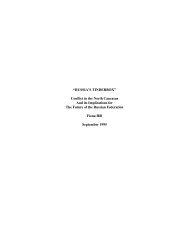Cumulative Deterrence and it's implementations to the War against ...
Cumulative Deterrence and it's implementations to the War against ...
Cumulative Deterrence and it's implementations to the War against ...
Create successful ePaper yourself
Turn your PDF publications into a flip-book with our unique Google optimized e-Paper software.
Pact allies. The threat of mutual assured destruction made <strong>the</strong> notion of a nuclear first strike<br />
unthinkable. Thus, confronted with horrific images of a “nuclear winter,” <strong>the</strong> superpowers, while<br />
never<strong>the</strong>less continuing <strong>to</strong> build up <strong>the</strong>ir nuclear arsenals <strong>to</strong> staggering heights over <strong>the</strong> next half<br />
century, s<strong>to</strong>pped short of giving <strong>the</strong> order <strong>to</strong> unleash even one of <strong>the</strong>se fearsome weapons.<br />
Although both <strong>the</strong> United States <strong>and</strong> <strong>the</strong> Soviet Union would engage in “proxy wars” throughout<br />
<strong>the</strong> Cold <strong>War</strong>, <strong>the</strong> threat that any of <strong>the</strong>se could escalate in<strong>to</strong> a nuclear exchange was a constant<br />
reminder of <strong>the</strong> awesome destructive power of <strong>the</strong>se two formidable adversaries.<br />
Scholars frequently define deterrence in dicho<strong>to</strong>mic terms. For Patrick Morgan,<br />
deterrence is “<strong>the</strong> use of threats of harm <strong>to</strong> prevent someone from doing something you do not<br />
want him <strong>to</strong>.” 3 Yehoshaphat Harkabi defines deterrence as <strong>the</strong> “threat of heavy punishment for<br />
an act by <strong>the</strong> enemy in order <strong>to</strong> persuade him <strong>to</strong> desist from that act.” 4 Zeev Maoz sees<br />
deterrence as “a policy through which one attempts <strong>to</strong> scare off a would-be attacker by holding<br />
out a drawn sword. It works as long as <strong>the</strong> sword is not being used. When <strong>the</strong> sword becomes<br />
covered with blood, deterrence is said <strong>to</strong> have failed, no matter whose blood was spilled.” 5 These<br />
<strong>and</strong> o<strong>the</strong>r st<strong>and</strong>ard definitions of deterrence share a common assumption: deterrence is successful<br />
so long as aggression does not take place; failure is <strong>the</strong> occurrence of a single violent act.<br />
In writing about <strong>the</strong> effectiveness of <strong>the</strong> threat of nuclear retaliation during <strong>the</strong> Cold <strong>War</strong>,<br />
two o<strong>the</strong>r highly respected scholars, Alex<strong>and</strong>er George <strong>and</strong> Richard Smoke, assert that although<br />
“‘massive retaliation’ was one enormously potent threat, it often lacked enough credibility <strong>and</strong><br />
relevance <strong>to</strong> deter some types of challenges <strong>to</strong> deterrence commitments made by <strong>the</strong> United<br />
States on behalf of its foreign policy interests.” 6 In some cases, a weaker adversary might adopt<br />
what George <strong>and</strong> Smoke refer <strong>to</strong> as <strong>the</strong> “designing around” appproach. 7 According <strong>to</strong> this<br />
approach an enemy that recognizes its operational limitations vis-à-vis a militarily superior<br />
opponent will readjust its tactics <strong>and</strong> operations <strong>to</strong> play <strong>to</strong> its strengths. 8 Examples include <strong>the</strong><br />
3. Patrick M. Morgan, <strong>Deterrence</strong>: A Conceptual Analysis (London: Sage, 1977), p. 17.<br />
4. Yehoshaphat Harkabi, <strong>War</strong> <strong>and</strong> Strategy (Hebrew) (Tel Aviv: Israel Ministry of Defense, 1990), p. 221.<br />
5. Zeev Maoz, Paradoxes of <strong>War</strong>: On <strong>the</strong> Art of National Self-Entrapment (Bos<strong>to</strong>n: Unwin Hyman 1990), p. 65.<br />
6. Alex<strong>and</strong>er L. George <strong>and</strong> Richard Smoke, “<strong>Deterrence</strong> <strong>and</strong> Foreign Policy,” World Politics, vol. 41, no. 2<br />
(January 1989), p. 177.<br />
7. Alex<strong>and</strong>er L. George <strong>and</strong> Richard Smoke, <strong>Deterrence</strong> in American Foreign Policy: Theory <strong>and</strong> Practice (New<br />
York: Columbia University Press, 1974), pp. 38–45, 519–522. See also Doron Almog, “The West Bank Fence: A<br />
Vital Component in Israel’s Strategy of Defense,” Special Studies on Palestinian Politics <strong>and</strong> <strong>the</strong> Peace Process,<br />
Research Memor<strong>and</strong>um no. 47 (Washing<strong>to</strong>n, D.C.: Washing<strong>to</strong>n Institute for Near East Policy, 2004), pp. 13–15. See<br />
also http://www.washing<strong>to</strong>ninstitute.org/pubs/working/almog.doc, pp. 9–10.<br />
8. Almog, “The West Bank Fence”; <strong>and</strong> http://www.washing<strong>to</strong>ninstitute.org/pubs/working/almog.doc.<br />
4
















